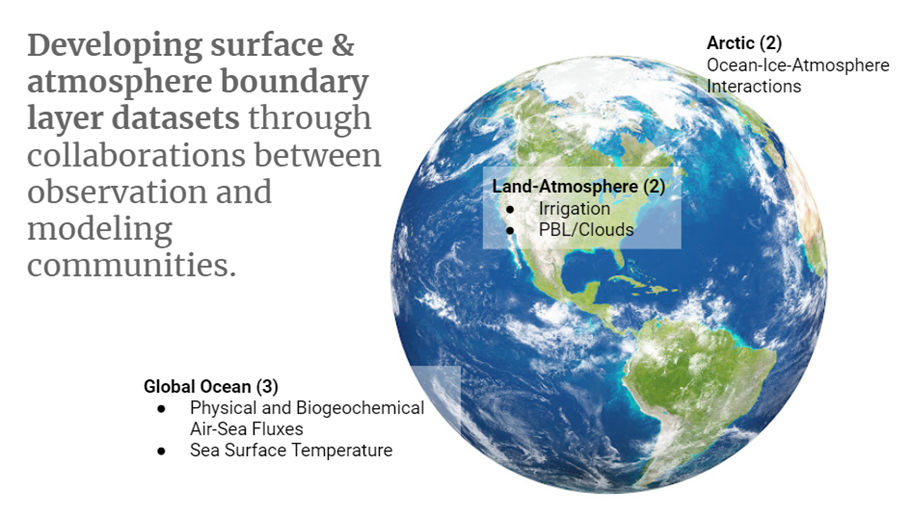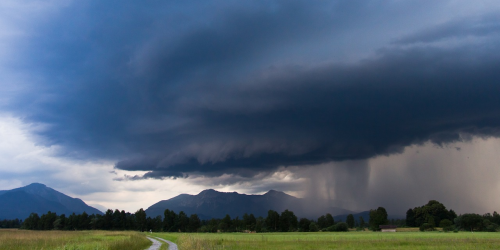NOAA’s Climate Observations and Monitoring (COM) Program is announcing seven new 2- or 3-year projects in Fiscal Year 2020 (FY20) that aim to improve the representation of critical atmospheric processes in our weather and climate models, through new or improved observation-based datasets. Using innovative techniques like new machine learning methods, the projects will focus on the mixing of air, moisture, and heat in the lowest layer of our atmosphere closest to the Earth’s surface—the atmospheric boundary layer—that drives our weather and climate around the world. These competitively selected projects total $2,965,509, including $2,080,133 in grants and $885,376 in other awards.

The motion and mixing in the atmospheric boundary layer can influence conditions like how much rain falls during a storm or a hurricane’s strength and trajectory. Improved understanding of atmospheric boundary layer processes and their interactions with the Earth’s surface is key to advancing weather and climate models and predictions. However, observations of these processes are limited.
The seven new COM-funded projects will leverage NOAA’s existing observational assets to develop datasets that will capture global physical and biogeochemical exchanges between the air and sea, and characterize land-atmosphere processes and ocean-ice-atmosphere interactions for targeted use by the climate modeling community. In many cases, researchers will draw on new machine learning methods to bring different types of observations and observational platforms together for model use. Projects will forge strong collaborations between the external research (seven universities) and NOAA research communities (five NOAA Research labs),NOAA line offices (NWS, NESDIS, OAR), and various federal agencies (NOAA, NASA, DOE).
The seven new projects funded by the COM Program in FY20 are:
- Development of an integrated ocean-atmosphere-sea ice dataset for validation of modeled Arctic boundary layer processes over an annual cycle
Leveraging the recent international field campaign to the Arctic (MOSAiC), this project will develop a dataset that characterizes the Arctic boundary layer, surface state and energy budget, and clouds over an annual cycle. Modelers will guide the development of the observational dataset to facilitate future studies of boundary layer processes and development of metricsfor evaluating these processes in models. The resulting dataset will have the potential to be used in improved modeling of the stable Arctic boundary layer and cloud feedbacks in the boundary layer.- PI: Taneil Uttal NOAA Physical Sciences Lab
- Co-PI: Amy Solomon NOAA Physical Sciences Lab; Cooperative Institute for Research in Environmental Sciences
- Co-Is: Leslie Hartten, Matthew Shupe, P. Ola G. Persson NOAA Physical Sciences Lab; Cooperative Institute for Research in Environmental Sciences
- Modern satellite/in situ-based air-sea turbulent heat flux products for the Arctic Ocean and adjacent seas
Leveraging contemporary air-sea variables and flux observations from unmanned saildrones (such as those collected by NOAA OAR PMEL), surface moorings, and satellites, this project will utilize machine learning methods to develop new heat flux products for the Arctic. Improved products will advance understanding of Arctic amplification mechanisms (rapid Arctic warming over the past several decades) and will be useful for advancing future modeling efforts at NOAA NWS Climate Prediction Center and NOAA/ESRL/Physical Sciences Lab.- PI: Lisan Yu, Woods Hole Oceanographic Institution
- Co-PI: Robert Weller, Woods Hole Oceanographic Institute
- Unfunded Collaborators: Michael Alexander NOAA OAR ESRL Pacific Marine Environmental Laboratory; Arun Kumar NOAA NWS NCEP Climate Prediction Center
- Employing a NOAA climate measurement network to create products for evaluation and improvement of boundary layer height and cloud interactions in climate models
Leveraging NOAA ESRL GML’s SURFRAD Network, the CHEESEHEAD field campaign, and others, this project will develop three new data products: 1) boundary layer heights, 2) cloud type classification, and 3) multivariate statistical summaries. These observational data products, developed in collaboration with NOAA’s climate modeling community, will fill gaps in quantifying how clouds impact surface radiation and the growth of the convective mixed layer over the course of the day for multiple climate regimes.- PI: Laura Riihimaki NOAA OAR ESRL Global Monitoring Lab, Cooperative Institute for Research in Environmental Sciences
- Co-PI: Joseph Sedlar NOAA OAR ESRL Global Monitoring Lab, Cooperative Institute for Research in Environmental Sciences; Joseph A. Santanello NASA Goddard Space Flight Center Hydrological Sciences Laboratory
- Co-I: Kathleen Lantz NOAA OAR ESRL Global Monitoring Lab, Cooperative Institute for Research in Environmental Sciences
- Unfunded Collaborators: Kirsten Findell Geophysical Fluid Dynamics Laboratory; Elena Shevliakova Geophysical Fluid Dynamics Laboratory; Shaocheng Xie Lawrence Livermore National Laboratory
- Developing an irrigation dataset for assessment of anthropogenic impacts on terrestrial-atmosphere energy-water coupling using machine learning-based data fusion
Employing new data fusion and machine learning methods, this project will bring together in-situ, remote sensing, and reanalysis data to develop an irrigation dataset that will improve understanding of how land-use decisions impact regional land-Arctic boundary layer interactions and climate. Application of the resulting dataset could serve as a use case and tool for the modeling community to examine gaps in representing key anthropogenic processes in models.- PI: Ruije Zeng Arizona State University Tempe campus
- Co-PIs: Tianfang Xu Arizona State University Tempe campus; Guo-Yue Niu University of Arizona
- Combining data and models for robust estimates of global air-sea CO2 fluxes
Employing an array of machine learning approaches, this project will develop improved observation-based estimates of air-sea CO2 fluxes with explicit uncertainty. Results from the funded project will be essential in supporting future NOAA OAR lab (GFDL, AOML, PMEL) activities, including testing Earth system/climate and ocean models, and process understanding studies.- PI: Galen A. McKinley, Columbia University
- Co-PI: Tian Zheng, Columbia University
- Unfunded Collaborators: Richard A. Feely NOAA OAR PMEL; Rik Wanninkhof NOAA OAR AOML; John Dunne NOAA OAR GFDL; Christian Rodenbeck, Max Planck Institute
- Improvements to the NOAA Optimal Interpolation analysis of sea surface temperatures
Leveraging NOAA’s increasing investments in in situ and satellite observations, this project will explore different methods and ultimately make improvements to NOAA’s gridded Daily Optimal Interpolation sea surface temperature product. An accurate sea surface temperature record is essential to providing the lower boundary condition for the atmospheric boundary layer, and is critical to weather and ocean forecasts, and the monitoring of climate and health of the marine environment.- PI: Jim Carton, University of Maryland
- Co-PI: Thomas Smith NOAA NESDIS; Boyin Huang NOAA NESDIS
- Unfunded Collaborators: Travis Sluka Joint Center for Satellite Data Assimilation; Huai-Min Zhang NOAA NESDIS; Andy Harris NOAA NESDIS; Eileen Maturi NOAA NESDIS
- Flux Products, long time-series, and diurnal cycle metrics from OceanSITES moored buoys as a baseline for climate monitoring and assessing model and satellite resolved air-sea interaction
Leveraging data and observations from OceanSITES moored buoys, this project will create four new product webpages to make existing data more accessible and discoverable. Webpages will highlight air-sea flux data, concatenated long time-series, deep ocean temperature and salinity data, and diurnal cycle metrics. In addition to a suite of monitoring applications, results of the project will be valuable and relevant to NOAA’s routine evaluation of model-based analyses products, such as the NCEP/NCAR Climate Forecast System Reanalysis.- PI: Meghan Cronin NOAA OAR Pacific Marine Environmental Lab
- Co-PIs: Dongxiao Zhang, Kevin O’Brien, Kenneth Connel University of Washington; NOAA OAR Pacific Environmental Laboratory; Cooperative Institute for Climate, Ocean, and Ecosystem Studies
- Unfunded Collaborators: Arun Kumar NOAA NCEP Climate Prediction Center





